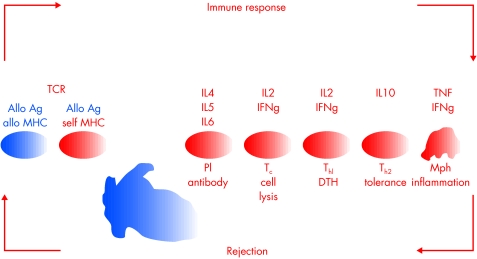Figure 1.
The alloimmune response consists of antigen (Allo Ag) presentation in the context of major histocompatibility (MHC) molecules either by donor cells or by recipient cells to the recipient's T cells via T cell receptor (TCR). This leads to T lymphocyte differentiation to CD4 T cells of T helper1 (Th1) or T helper2 (Th2) phenotype, CD8 cytotoxic T cells (Tc), and B lymphocyte development into plasma cells producing specific clones of antibodies. These immunocompetent cells destroy the allogeneic graft cells. In addition, an inflammatory response by the innate immune system involving macrophages (Mph) participates in this networked alloimmune response. Cytokines (IL2-10, TNF, IFng) play an important role in this orchestrated response. The Th2 subset may favour graft acceptance.

